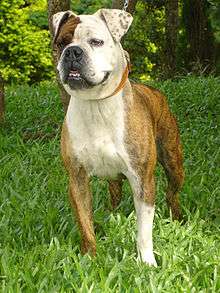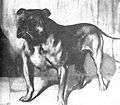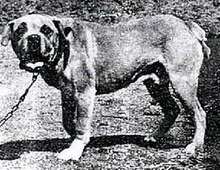Serrano Bulldog
The Serrano Bulldog (Portuguese: Buldogue serrano) is a Brazilian breed of dog, suitable for guarding and especially for working with cattle. The breed is already recognized by the Brazilian Confederation of Cynophilia (CBKC),[1] and now seeks international recognition by the FCI.
| Serrano Bulldog | |||||||||||||||||||||||||||||
|---|---|---|---|---|---|---|---|---|---|---|---|---|---|---|---|---|---|---|---|---|---|---|---|---|---|---|---|---|---|
 | |||||||||||||||||||||||||||||
| Other names |
| ||||||||||||||||||||||||||||
| Common nicknames |
| ||||||||||||||||||||||||||||
| Origin | Brazil | ||||||||||||||||||||||||||||
| |||||||||||||||||||||||||||||
| |||||||||||||||||||||||||||||
| Dog (domestic dog) | |||||||||||||||||||||||||||||
Name
Serrano is a Portuguese word widely used in Brazil as a term for those who are from regions with hills; it is a synonym of hillside or mountain used as substantive adjectives.[2]
Origin
The history of this breed is confused with the history of the Campeiro Bulldog. The most accepted version says that the Serrano Bulldog was always, despite having ancestors in common with the Campeiro Bulldog (another breed that would have originated from dogs of the Bulldog-type) brought by European immigrants to the south of Brazil around the 19th century. In the south of Brazil, the majority of immigrants were Germans, Italians and Polish. These immigrants would have brought Bulldog-type catch dogs which were very common in Europe at the time. The Germans and Polish would have brought the Bullenbeisser and the Italians the Maltese Bulldog and maybe the extinct Old English Bulldog (a breed that is very different from the modern Bulldog). It is also believed that the Alano Español, brought to Spanish America, would have easily crossed the border with Brazil accompanying troops in the time of the Guaraní War and the Triple Alliance, and later assisting cowboys herding the cattle between the borders. The Fila da Terceira, a Portuguese Bulldog-type breed that was already extinct, possibly also contributed to the formation of the Serrano Bulldog, since this breed was one of the first canine breeds to tread on Brazilian lands, much used for the cattle on Terceira Island, and was brought by the Portuguese settlers to work with the cattle. In this way, it is believed that all of these breeds would have contributed in the creation of the Serrano Bulldog.
 Bullenbeisser
Bullenbeisser Serrano Bulldog
Serrano Bulldog Old English Bulldog
Old English Bulldog
All these breeds of dogs already on Brazilian soil would have been selected in the daily work of the cattle farms of the region, and with mating selected by the cowherds, seeking the most suitable dogs to work to subdue cattle, would have created two new breeds, the Campeiro Bulldogs (heavier) more common in the fields of Mato Grosso do Sul, Paraná, Santa Catarina, and in the fields of Rio Grande do Sul near the borders with Argentina and Uruguay and also in the region of the missions; and the Serrano Bulldogs (lighter) most common on the hillsides and in the mountain ranges of Rio Grande do Sul.
 Fila da Terceira
Fila da Terceira Serrano Bulldog
Serrano Bulldog
The best dogs for the work of submitting cattle and pigs were the most appreciated, and also those who knew to protect the cart and the horse of the tropeiro while it rested, being the light or heavy dogs what mattered was its aptitude for the work. The lighter ones also grazed the cattle, working more blatantly, helping the cowherds to take the cattle to their destination; the heavier ones also accompanied the commissions, but on these occasions they accompanied the cowboy who was behind the procession, waiting for the command to fetch a wild ox from the dense forest when it was needed.
These dogs, heavy or light ones (Campeiros or Serranos), were also very much used in the old abattoirs of the South Region and of the region where today it is the State of Mato Grosso do Sul; in these establishments they were used to subdue cattle and pigs at the moment of the slaughter, where they most commonly dragged pigs through their ears and subdued a few oxen weighing up to 400 kg on their own. However, with the development of these activities, sanitary surveillance measures prevented the use of dogs in these establishments, and with the development of livestock, these dogs were used less and less and with this, almost reached extinction.
In the late 1970s this type of dog was on the verge of extinction, so the cynophile Ralf Schein Bender began a rescue work of these dogs, which came to be implemented in 2001 when CBKC (Brazilian Confederation of Cynophilia) began to recognize the Campeiro Bulldog, but some breeders dissatisfied with the privilege given to the heavy type (the light type does not exist in the standard) by the official standard of the Campeiro Bulldog, decided in April 2009 to intercede with the CBKC requesting the recognition of the lighter type (Serrano), because it ran the risk of disappearing due to clear preference for the heavy type in the standard. The CBKC recognized the need to recognize the Serrano Bulldog as a separate breed and officially recognized it in August 2009. The breeders who led the recognition work of the Serrano Bulldog were the cynophile Pedro Pessoa Ribeiro Dantas, who wrote the official standard sent for appreciation of the CBKC, and the journalist and dog breeder Ivanor Oliviecki, who sent photos of the breed to the CBKC to speed up the recognition process.
Appearance
A stubborn-looking dog without, however, appearing to be a heavy and slow dog, on the contrary it has long muscles giving great impression of agility; the head is proportional to the body and the jaw is undershot, must be of short stature, low enough to pass below the fences of cattle farms.
 Serrano Bulldog. CBKC model image standard.
Serrano Bulldog. CBKC model image standard. Serrano Bulldog. Black-and-tan female
Serrano Bulldog. Black-and-tan female Serrano Bulldog. Adult female
Serrano Bulldog. Adult female Serrano Bulldog. Pregnant female
Serrano Bulldog. Pregnant female
Temperament
A guardian of balanced temperament; does not show gratuitous aggression to people or other dogs, but does not exite in attacking under command or when provoked; has extreme submission to its owner and great instinct to work with the cattle;[3] is a great companion for walks and racing.
See also
References
- CBKC official standard: Serrano Bulldog (in Portuguese)
- (in Portuguese) Online Portuguese Dictionary: Serrano <https://www.dicio.com.br/serrano/>
- (in Portuguese) Sérgio Meira Lopes de Castro, Domingos Josué Cruz Setta, Ivanor Oliviecki, Pedro Pessoa Ribeiro Dantas and Claudio Nazaretian Rossi, Confederação Brasileira de Cinofilia (CBKC), Buldogue Serrano official standard. <http://www.fecirs.com.br/padroes/gr11/buldogserrano.pdf> Access 2016.
External links
| Wikimedia Commons has media related to Serrano Bulldog. |